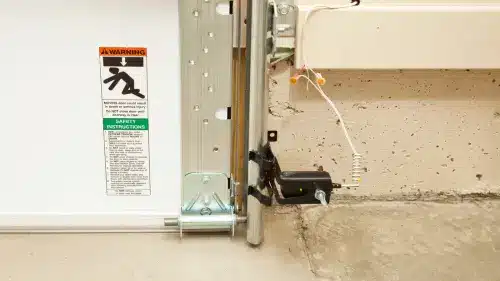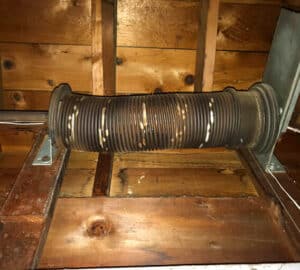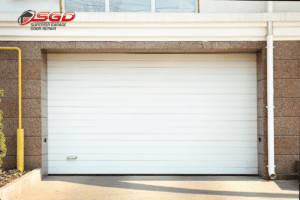Is your garage door sensor acting weird? Learn how to tell if it’s time for a replacement to ensure your home’s safety and security. These sensors ensure the door reverses its course if it encounters an obstruction while closing, preventing injuries and potential damage. However, like any other device, they can wear out over time and replacing garage door sensors is required. Here are some signs that might indicate it’s time for a new sensor:
1. Inconsistent Operation
When your garage door exhibits inconsistent behavior, like:
- Opening and closing at random times
- Refusing to close completely
- Reversing direction unexpectedly without any obstacles
These problems can often be traced back to faulty garage door sensors.
Here’s why:
- Sensor Misalignment: If the sensors are misaligned, they may not properly detect the infrared beam, leading to confusion about the door’s position. This can cause the door to open or close unexpectedly, or even reverse direction if it “thinks” something is blocking its path.
- Malfunctioning Sensors: Over time, sensors can wear out or become damaged, affecting their ability to send and receive the infrared signal accurately. This can again lead to erratic behavior from the garage door.
- Obstructed Sensors: While less likely if there are no visible obstructions, dirt, dust, or cobwebs building up on the sensor lenses can also interfere with the infrared beam, causing inconsistent operation.
Therefore, if you experience any of the mentioned inconsistencies with your garage door, it’s important to check the sensors for misalignment, clean them if necessary, and consider replacing them if they appear damaged or are nearing their expected lifespan (around 5-7 years).
2. Sensor Light is Off
When your garage door sensor light is off, it signifies a potential problem hindering the sensor’s ability to function correctly. Here’s a breakdown of what it might mean and what to do:
a. Lack of Power:
- The most common reason for a dead sensor light is a power issue. This could be due to:
- Disconnected power cord: Check if the cord is securely plugged into both the outlet and the sensor unit.
- Tripped circuit breaker: Locate the circuit breaker controlling your garage door opener and ensure it hasn’t tripped. Reset it if necessary.
- Power outage: If the entire garage lacks power, it could be a general power outage in your area.
b. Faulty Sensor:
- If you’ve verified that the power supply is functioning well, a faulty sensor itself could be the culprit. This could be due to:
- Internal component failure: Over time, internal components within the sensor can wear out or malfunction.
- Physical damage: If the sensor has sustained any physical damage, like impact or water exposure, it might be compromised.
Troubleshooting Steps:
- Double-check the power: Ensure the power cord is connected properly and the circuit breaker hasn’t tripped.
- Consult the user manual: Your garage door opener’s manual might offer specific troubleshooting steps for your sensor model.
- Seek professional help: If you’re not comfortable troubleshooting yourself or suspect a faulty sensor, it’s best to call a qualified garage door technician for diagnosis and repair.
Remember, a functioning sensor light is crucial for your garage door’s safety features. If troubleshooting doesn’t resolve the issue, replacing the sensor is recommended to ensure the safe operation of your garage door.
3. Physical Damage
Look closely at your garage door sensors for any signs of physical damage that could be preventing them from functioning properly. Here are some specific things to check:
- Frayed Wires: The wires connecting the sensors to the system could become frayed or damaged over time due to wear and tear, or from being pinched by the door itself.
- Cracks or Breaks: The plastic casing of the sensor itself could be cracked or broken, exposing the internal components to dust, moisture, or even causing internal damage.
- Water Damage: If your garage has experienced moisture issues, the sensors might be damaged by water intrusion, leading to malfunctioning.
- Misalignment: Though not always caused by physical damage, misalignment can also be a result of a physical impact. Check if the sensors are still positioned correctly and their beams are aligned.
If you find any of these signs of physical damage, attempting to repair the sensors yourself is not recommended. Damaged sensors can compromise the safety function of your garage door opener, potentially leading to accidents. In such cases, it’s crucial to replace the damaged sensor with a new one to ensure proper operation and safety.
4. Cleaning Doesn’t Help
Many common garage door sensor issues can be resolved by simply cleaning the lenses with a soft, dry cloth. However, if you experience malfunctioning even after cleaning:
- Check for internal damage: Sometimes, dirt or debris might be lodged deeper within the sensor housing, impacting its functionality. While attempting self-repair isn’t recommended, you can visually inspect the sensor for any visible cracks, moisture damage, or loose internal components.
Remember, if you’re unsure about the cause of the malfunction or uncomfortable with any repairs, it’s always best to consult a qualified garage door technician for assistance.
5. Frequent False Alarms
When your garage door reverses direction even though there seems to be nothing blocking its path, it can be quite frustrating and potentially a safety concern. This behavior can often be attributed to frequent false alarms from your garage door sensors.
Here’s a deeper explanation of how frequent false alarms indicate a potential sensor issue:
- Sensor Malfunction: A faulty sensor can become overly sensitive or its internal components might malfunction, causing it to misinterpret even minor fluctuations in the infrared beam as an obstruction. This triggers the safety mechanism and reverses the door’s direction even when there’s nothing in the way.
- Sensor Misalignment: Slight misalignments between the two sensors can also lead to false alarms. Even a small misalignment can disrupt the complete beam connection, causing the system to interpret this as an obstruction and triggering a reversal.
- Faulty Wiring: Damaged or corroded wires connecting the sensors to the opener can cause signal disruptions. These disruptions can mimic an obstruction and lead to false alarms.
- Environmental Factors: Sudden changes in light, like bright sunlight hitting the sensors directly, can temporarily disrupt the infrared beam and trigger a false alarm. However, frequent false alarms even in controlled lighting conditions point towards a sensor problem.
What to Do:
- If you experience frequent false alarms, start with cleaning the sensors with a soft, dry cloth to remove any dust or debris that might be affecting the beam.
- Check for misalignment by visually inspecting if the sensor lights are both illuminated and if the sensors appear level. You can try gently adjusting them back into alignment if necessary.
- If cleaning and alignment don’t solve the issue, it’s recommended to consult a qualified garage door technician. They can diagnose the problem and determine if sensor replacement is necessary.
Remember, a properly functioning garage door sensor is crucial for safety. By addressing frequent false alarms promptly, you can ensure your garage door operates smoothly and prevents potential accidents.
6. Old Age
Like any other electronic device, garage door sensors have a lifespan. Typically, they last around 5-7 years. If your sensors are older than this and you’re starting to experience issues like those mentioned above, even after troubleshooting, replacing them is a good preventative measure. This can help ensure your garage door functions properly and avoid potential safety hazards.
Conclusion
A malfunctioning garage door sensor can compromise your home’s security and safety. If you notice any of these signs, it’s best to consult with a professional or replace the sensor yourself if you’re comfortable doing so. Remember, regular maintenance and prompt replacement of faulty parts can prolong the life of your garage door and ensure it operates safely and efficiently.
Frequently Asked Questions
Q: What are the common signs that my garage door sensor needs to be replaced?
A: Several signs indicate a potential need for sensor replacement, including: Inconsistent operation, Sensor light is off, Physical damage, Cleaning doesn’t help, Frequent false alarms and Old age.
Q: What should I do if I suspect a faulty sensor?
A: Check for simple fixes, Consult the user manual or Seek professional help.
Q: Can I repair a damaged sensor myself?
A: For safety reasons, it’s best to replace a visibly damaged garage door sensor with a new one instead of attempting repairs yourself.
Q: How often should I replace my garage door sensors?
A: Garage door sensors should be replaced every 5-7 years, or sooner if experiencing minor issues.
Q: How can I prevent future sensor problems?
A: Regularly maintain your garage door sensors by cleaning them, checking for damage, and replacing them every 5-7 years for smooth and safe operation.








